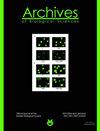The significance of Fas, tumor necrosis factor-related apoptosis-inducing ligand and fibrinolytic factors in the assessment of malignant pleural effusion
IF 0.8
4区 生物学
Q4 BIOLOGY
引用次数: 0
Abstract
Few studies have examined the usefulness of soluble apoptotic markers for the screening of pleural effusion. This study aimed to investigate the significance of Fas, tumor necrosis factor-related apoptosis-inducing ligand (TRAIL) and fibrinolytic factors for the assessment of patients with malignant pleural effusion. A total of 137 patients with pleural effusion were evaluated. Soluble Fas, TRAIL, tissue-type plasminogen activator (tPA), plasminogen activator inhibitor-1 (PAI-1), D-dimers and lactate dehydrogenase (LD) levels were measured. Pleural fluid/blood ratios (P/B) of fibrinolytic factors were calculated. Fas and TRAIL levels were significantly higher in patients with malignant effusion than in those with non-malignant effusion. Malignant effusion was 1.6-fold more prevalent in patients with elevated Fas than in those without (48.5% vs 30.4%, P=0.031). The P/B ratio of tPA was 2.5-fold higher in malignant effusion than in non-malignant effusion (4.65 vs 1.83, P<0.001). Fas was positively correlated with tPA and D-dimers, but not with biochemical parameters. The ability of Fas to identify malignant effusions was significantly greater than those of tPA and LD. In conclusion, measurements of Fas and TRAIL in conjunction with fibrinolytic factors may provide information useful for monitoring patients with suspected malignant pleural effusion.Fas、肿瘤坏死因子相关凋亡诱导配体及纤溶因子在恶性胸腔积液评价中的意义
很少有研究检查可溶性凋亡标志物在筛选胸腔积液中的作用。本研究旨在探讨Fas、肿瘤坏死因子相关凋亡诱导配体(tumor necrosis factor- associated apoptosis-inducing ligand, TRAIL)和纤溶因子在恶性胸腔积液患者评估中的意义。我们对137例胸腔积液患者进行了评估。测定可溶性Fas、TRAIL、组织型纤溶酶原激活物(tPA)、纤溶酶原激活物抑制剂-1 (PAI-1)、d -二聚体和乳酸脱氢酶(LD)水平。计算胸水/血纤溶因子比(P/B)。Fas和TRAIL水平在恶性积液患者中明显高于非恶性积液患者。Fas升高患者的恶性积液发生率是无Fas升高患者的1.6倍(48.5% vs 30.4%, P=0.031)。恶性积液中tPA的P/B比非恶性积液高2.5倍(4.65 vs 1.83, P<0.001)。Fas与tPA和d -二聚体呈正相关,但与生化参数无关。Fas识别恶性胸腔积液的能力明显高于tPA和LD。总之,Fas和TRAIL结合纤溶因子的测量可能为监测疑似恶性胸腔积液患者提供有用的信息。
本文章由计算机程序翻译,如有差异,请以英文原文为准。
求助全文
约1分钟内获得全文
求助全文
来源期刊
CiteScore
1.40
自引率
0.00%
发文量
25
审稿时长
3-8 weeks
期刊介绍:
The Archives of Biological Sciences is a multidisciplinary journal that covers original research in a wide range of subjects in life science, including biology, ecology, human biology and biomedical research.
The Archives of Biological Sciences features articles in genetics, botany and zoology (including higher and lower terrestrial and aquatic plants and animals, prokaryote biology, algology, mycology, entomology, etc.); biological systematics; evolution; biochemistry, molecular and cell biology, including all aspects of normal cell functioning, from embryonic to differentiated tissues and in different pathological states; physiology, including chronobiology, thermal biology, cryobiology; radiobiology; neurobiology; immunology, including human immunology; human biology, including the biological basis of specific human pathologies and disease management.

 求助内容:
求助内容: 应助结果提醒方式:
应助结果提醒方式:


